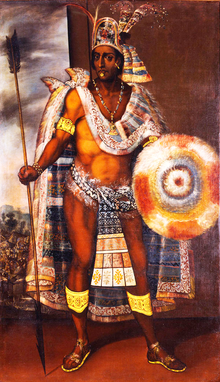
Back Moctezuma II Afrikaans مونتيزوما Arabic مونتيزوما (سياسى من آزتك) ARZ Moctezuma Xocoyotzin AST Moctezuma Aymara II Montezuma Azerbaijani ایکینجی موکتزومای AZB Мантэсума II Byelorussian Moktezuma II Breton Moctezuma II Catalan
| Moctezuma II | |
|---|---|
 Late 17th-century portrait attributed to Antonio Rodríguez | |
| Reign | 1502/1503–1520 |
| Coronation | 1502/1503 |
| Predecessor | Ahuitzotl |
| Successor | Cuitláhuac |
| King consort of Ecatepec | |
| Tenure | 16th century–1520 |
| Born | c. 1471 |
| Died | 29 June 1520 (aged 48–49) Tenochtitlan, Mexico |
| Consort | |
| Issue Among others |
|
| Father | Axayacatl |
| Mother | Xochicueyetl |

Moctezuma Xocoyotzin[N.B. 1] (c. 1466 – 29 June 1520), referred to retroactively in European sources as Moctezuma II,[N.B. 2] was the ninth Emperor of the Aztec Empire (also known as the Mexica Empire),[1] reigning from 1502 or 1503 to 1520. Through his marriage with Queen Tlapalizquixochtzin of Ecatepec, one of his two wives, he was also king consort of that altepetl.[2]
The first contact between the indigenous civilizations of Mesoamerica and Europeans took place during his reign. He was killed during the initial stages of the Spanish conquest of the Aztec Empire when conquistador Hernán Cortés and his men fought to take over the Aztec capital Tenochtitlan. During his reign, the Aztec Empire reached its greatest size. Through warfare, Moctezuma expanded the territory as far south as Xoconosco in Chiapas and the Isthmus of Tehuantepec, and incorporated the Zapotec and Yopi people into the empire.[3] He changed the previous meritocratic system of social hierarchy and widened the divide between pipiltin (nobles) and macehualtin (commoners) by prohibiting commoners from working in the royal palaces.[3]
Though two other Aztec rulers succeeded Moctezuma after his death, their reigns were short-lived and the empire quickly collapsed under them. Historical portrayals of Moctezuma have mostly been colored by his role as ruler of a defeated nation, and many sources have described him as weak-willed, superstitious, and indecisive.[4] Depictions of his person among his contemporaries, however, are divided; some depict him as one of the greatest leaders Mexico had, a great conqueror who tried his best to maintain his nation together at times of crisis,[5] while others depict him as a tyrant who wanted to take absolute control over the whole empire.[6] Accounts of how he died and who were the perpetrators (Spaniards or natives) differ. His story remains one of the most well-known conquest narratives from the history of European contact with Native Americans, and he has been mentioned or portrayed in numerous works of historical fiction and popular culture.
Cite error: There are <ref group=N.B.> tags on this page, but the references will not show without a {{reflist|group=N.B.}} template (see the help page).
- ^ "Aztec Political Structure". Tarlton Law Library. Archived from the original on 11 January 2023. Retrieved 10 March 2020.
- ^ Chimalpahin 1997, p. 101.
- ^ a b Hassig 1988, p. 221.
- ^ Williamson, Edwin (1992). The Penguin history of Latin America. New York: Penguin Books. p. 18. ISBN 0-14-012559-0. OCLC 29998568.
- ^ Díaz del Castillo 2011, p. 428.
- ^ de Alva Ixtlilxóchitl 1892, p. 321.